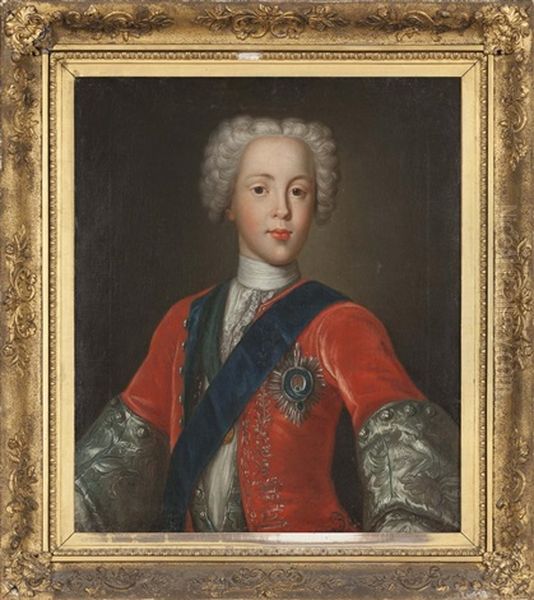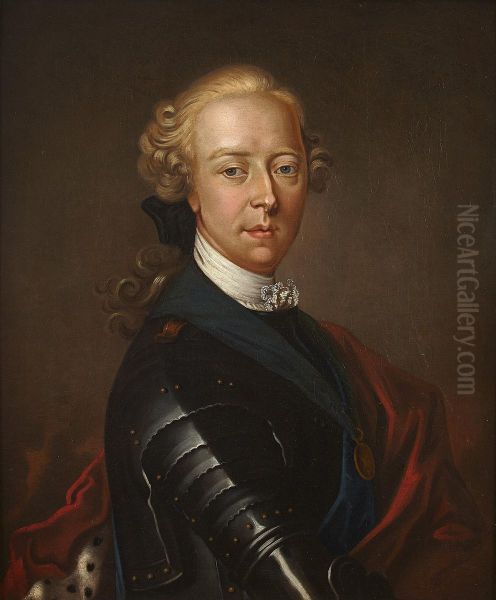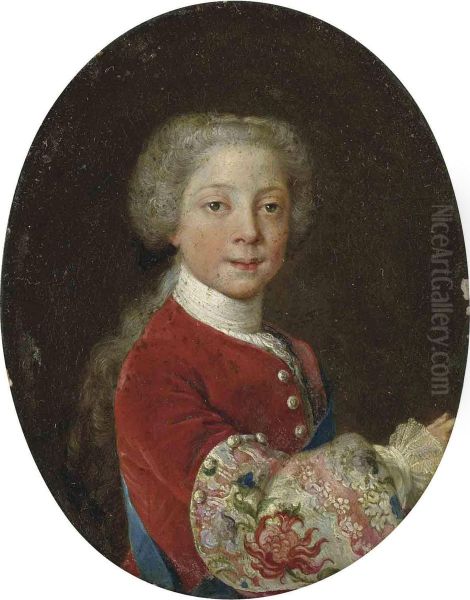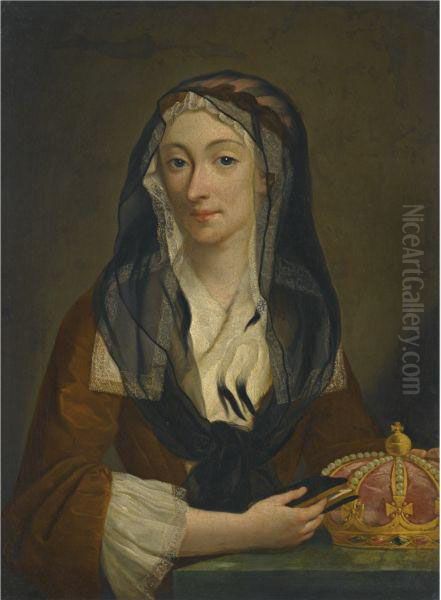Antonio David (c. 1698–1750) was an Italian painter primarily active during the late Baroque and early Rococo periods. While perhaps not as universally recognized today as some of his towering contemporaries, David carved out a significant niche for himself, particularly as a portraitist. His work provides a fascinating window into the aristocratic and ecclesiastical circles of his time, most notably his engagement with the exiled Stuart court in Rome. His paintings are characterized by a refined attention to detail, a sensitivity to the status and personality of his sitters, and an adherence to the prevailing aesthetic ideals of elegance and representation.
Early Life and Artistic Milieu
Information regarding Antonio David's earliest years and precise artistic training remains somewhat elusive, a common challenge when studying artists who were not in the absolute first rank of fame during their lifetimes. Born around 1698, he emerged into an Italian art world that was rich, complex, and undergoing stylistic transitions. Venice, a likely place for his early artistic immersion, was a vibrant center, home to masters like Rosalba Carriera, who was revolutionizing portraiture with her delicate pastels, and Giovanni Battista Tiepolo, whose grand-scale decorative works were defining the Rococo.
Whether David received his foundational training in Venice or elsewhere in Italy, he would have been exposed to the lingering grandeur of the High Baroque, exemplified by artists like Luca Giordano or Francesco Solimena in Naples, and the emerging lighter, more graceful sensibilities of the Rococo. The traditional apprenticeship system would have involved years of drawing, copying masterworks, and assisting in a senior artist's studio, gradually learning the crafts of paint preparation, canvas handling, and compositional principles.
The Roman Context and Jacobite Patronage

Antonio David’s career significantly blossomed in Rome. By the early 18th century, Rome was still a magnetic center for artists across Europe, though its dominance was being challenged by Paris. It was a city of immense artistic heritage, from classical antiquity to the Renaissance masters like Raphael and Michelangelo, and the more recent Baroque titans such as Gian Lorenzo Bernini and Caravaggio. The influence of painters like Carlo Maratta, who had dominated the Roman school in the later 17th century with his classical-Baroque synthesis, was still palpable.
It was in Rome that David found his most significant patrons: the exiled Stuart court. James Francis Edward Stuart (the "Old Pretender"), son of the deposed King James II of England, maintained a court in Rome, recognized by the Pope as the rightful King of England, Scotland, and Ireland. This court, though lacking a kingdom, sought to project an image of legitimacy and regal dignity, and art played a crucial role in this endeavor.
Antonio David became a favored painter for the Jacobites. He was commissioned to paint portraits of James Francis Edward Stuart himself, as well as his two sons, Charles Edward Stuart ("Bonnie Prince Charlie" or the "Young Pretender") and Henry Benedict Stuart (later Cardinal Duke of York). These portraits were not mere likenesses; they were political statements, designed to convey majesty, lineage, and the enduring claim to the British throne. David was adept at capturing the requisite regal bearing, the richness of fabrics, and the symbols of status, fulfilling the court's need for dignified representation. In 1718, he was reportedly granted a royal warrant, officially recognizing him as a painter to the Stuart court.
Artistic Style and Influences
Antonio David’s style is firmly rooted in the late Baroque tradition, yet it also shows an awareness of the emerging Rococo elegance and a certain classical restraint that was common in Roman painting of the period. His portraits are generally characterized by a careful delineation of features, a smooth application of paint, and a keen eye for the textures of silks, velvets, and lace, which were essential components of aristocratic attire.
Several artistic currents and individual painters likely influenced David's development:
The broader Baroque aesthetic, with its emphasis on drama, rich color, and dynamic compositions, formed the foundational language. While David's portraits are often more staid than the exuberant works of, say, Peter Paul Rubens or Bernini, the underlying principles of conveying grandeur and psychological presence are there.

In Rome, he would have been aware of the legacy of portraitists like Jacob Ferdinand Voet, a Flemish painter who had been highly successful in Rome in the late 17th century, known for his sophisticated and often flamboyant portraits of Roman society and visiting dignitaries. Voet’s attention to costume and his ability to capture a sense of lively presence set a high bar.
The work of Carlo Maratta (1625-1713) and his studio was also pervasive. Maratta’s style, a more classical and restrained version of Baroque, became the dominant mode in Rome for decades. Artists like Agostino Masucci (c. 1691–1758), a contemporary of David and a pupil of Maratta, worked in a similar vein. Masucci also received commissions from the Stuart court, such as his painting "The Solemnisation of the Marriage of King James III and Clementina," indicating a shared circle of patronage and likely artistic exchange or at least mutual awareness.
The elegance and refined sensibility found in David's work also align with the developing Rococo style, though his portraits generally avoid the overt frivolity or intimacy sometimes associated with French Rococo masters like Jean-Antoine Watteau or François Boucher. Instead, his Rococo influence manifests in a certain gracefulness, a softer modeling of forms, and an appreciation for decorative detail.
One can also see parallels with the work of Pompeo Batoni (1708–1787), who became the leading portraitist in Rome slightly after David’s main period of activity. Batoni perfected the "Grand Tour" portrait, often depicting young British noblemen amidst classical ruins. While David’s primary patrons were the Stuarts, the general demand for elegant and status-affirming portraiture was high in Rome, and his work shares with Batoni an emphasis on polished technique and sophisticated presentation. Other Roman contemporaries whose work formed part of the artistic milieu included Francesco Trevisani, who also painted for the Stuarts, Benedetto Luti, and Sebastiano Conca. The French painter Pierre Subleyras, active in Rome, was another significant figure known for his portraits and religious works.
The influence of earlier Venetian portraiture, perhaps from masters like Giovanni Maria Moroni (though from a much earlier period, his naturalism in portraiture had a long legacy), might also be discerned in David's commitment to capturing a convincing likeness, albeit filtered through the more formal conventions of his own era.
Representative Works
While a comprehensive catalogue raisonné of Antonio David's work might be difficult to assemble, several key pieces and types of works define his output:

Portraits of the Stuart Royal Family: These are arguably his most historically significant works.
Portrait of James Francis Edward Stuart: These depictions aimed to present the "Old Pretender" with the dignity and authority befitting a monarch. Details of attire, such as armor or rich robes, and symbolic accoutrements would have been carefully chosen.
Portrait of Prince Charles Edward Stuart: As the heir apparent, portraits of "Bonnie Prince Charlie" were crucial for maintaining his image, especially as he grew older and prepared for his ill-fated attempt to reclaim the throne in 1745. David captured him at various ages, often emphasizing his youthful appeal and princely bearing.
Portrait of Henry Benedict Stuart: The younger son, who later pursued an ecclesiastical career and became a Cardinal, was also a frequent subject. David’s portraits would have charted his progression and status within both the Stuart lineage and the Church.
These royal portraits were often replicated in various formats, including miniatures, to be distributed among Jacobite supporters across Europe, serving as tokens of loyalty and reminders of the Stuart claim.
Other Aristocratic and Ecclesiastical Portraits:
Ritratto del signore Bonerati di Rovere (Portrait of Signore Bonerati di Rovere): This work, mentioned as a copperplate oil painting, exemplifies his skill in smaller-scale, detailed portraiture. Such works would have been prized for their intimacy and precision. The choice of copper as a support often allowed for a very smooth, enamel-like finish.
Ritratto di Roma (Portrait of Rome): The exact nature of this work is intriguing. It could be an allegorical personification of the city, a common theme in Baroque art, or perhaps a portrait of an individual with a prominent view of Rome in the background, signifying their connection to the city. If allegorical, it would showcase a different facet of David's abilities beyond straightforward likeness.

His portraits generally follow the conventions of the time: sitters are often depicted three-quarter length or bust length, posed to convey their social standing. Men might be shown in armor, formal court dress, or clerical robes, while women would be adorned in fashionable silks and jewels. The backgrounds are often simple, dark, or feature architectural elements or drapery to enhance the sense of formality. David’s strength lay in his ability to render these elements with precision and to imbue his sitters with a sense of composed dignity.
Students and Workshop
The transmission of artistic knowledge was central to the art world of the 18th century. While Antonio David may not have run a large, factory-like studio in the manner of some of his more famous contemporaries, he likely had assistants and pupils. The names Amate Padilla and López de la Nieta Díaz del Campo have been associated with him as students. The Spanish-sounding names are interesting; it's possible these individuals traveled to Rome to study, a common practice, or that David had connections or a period of activity that brought him into contact with Spanish artists. Further research would be needed to clarify the nature and extent of these relationships.
A workshop would have assisted with preparing canvases, grinding pigments, painting less critical areas of compositions (such as drapery or backgrounds), and producing copies or versions of successful portraits, particularly those of the Stuart family, for which there would have been a consistent demand.
Contemporaries and the Artistic Milieu of Rome
Antonio David worked in a Rome teeming with artistic talent and international connections. Beyond those already mentioned as direct influences or stylistic parallels, the city hosted a diverse community of painters. French artists were particularly prominent, with the French Academy in Rome serving as a vital institution. Painters like Jean-François de Troy, director of the French Academy, or Étienne Parrocel were active.
The environment was competitive but also collaborative. Artists would have seen each other's work in churches, palaces, and public exhibitions. The Accademia di San Luca, Rome's official artists' academy, provided a forum for discussion and the upholding of artistic standards. While direct records of David's interactions with many of these figures may be scarce, he was undoubtedly part of this vibrant artistic ecosystem. His specialization in portraiture, particularly for a specific and high-profile clientele like the Jacobites, allowed him to cultivate a distinct practice within this broader scene. The patronage of the Church also remained immensely important, with cardinals and other high-ranking clergy commissioning altarpieces, frescoes, and, of course, portraits from artists like David.
Legacy and Art Historical Assessment
Antonio David's legacy is primarily that of a skilled and reliable portraitist who served an important historical clientele. His works are valuable historical documents, offering visual records of the key figures in the Jacobite movement. They capture the aspirations and the cultivated image of a court in exile, fighting to maintain its relevance and legitimacy on the European stage.
In the grand narrative of art history, David is often overshadowed by figures who were more innovative or who worked on a grander scale, such as Tiepolo in Venice or later, Anton Raphael Mengs, who became a leading proponent of Neoclassicism in Rome towards the end of David's life and just after. However, within the specific domain of Jacobite portraiture, David holds a significant place. His paintings are essential visual resources for historians studying the Stuarts and the Jacobite cause.
From an art historical perspective, his work is representative of a particular moment in Roman painting – a competent and elegant late Baroque style that was beginning to absorb the lighter graces of the Rococo before the more austere and archaeologically-inspired Neoclassicism took hold. His paintings demonstrate technical proficiency, a good understanding of likeness and character (within the formal constraints of the era), and a sensitivity to the requirements of elite patronage.
While his works may not frequently appear in major museum exhibitions dedicated to the titans of the 18th century, they are preserved in various collections, particularly those with connections to Scottish or Jacobite history, and occasionally surface in the art market. The study of artists like Antonio David enriches our understanding of the period, revealing the depth and breadth of artistic production beyond the most famous names. He represents the many skilled painters who catered to the diverse needs of patrons, contributing to the rich artistic fabric of 18th-century Italy.
His adherence to established conventions, while ensuring his success with patrons who valued dignity and tradition, perhaps limited his scope for radical innovation. Yet, it is precisely this adherence that makes his work so valuable as a reflection of the tastes and values of his time and circle. He was a master of his craft within his chosen specialty, fulfilling his commissions with a consistent level of quality and refinement.
Conclusion
Antonio David navigated the complex art world of 18th-century Italy, establishing himself as a respected portrait painter, most notably in Rome. His association with the exiled Stuart court provided him with a unique and historically significant role, immortalizing the faces of a dynasty clinging to its claims and its dignity. His style, a blend of late Baroque solidity and Rococo grace, was well-suited to the demands of his patrons, who required portraits that conveyed status, authority, and a sense of enduring legitimacy.
While the dramatic narratives of art history often focus on revolutionary figures, the contributions of skilled artists like Antonio David are essential for a complete picture. His paintings offer more than just likenesses; they are cultural artifacts that speak of political aspirations, social hierarchies, and the enduring power of the painted image to shape perception and preserve memory. His work remains a testament to his skill and an important visual chronicle of a fascinating chapter in European history.